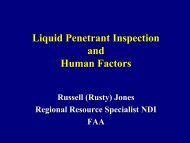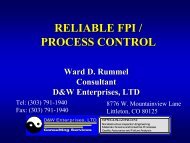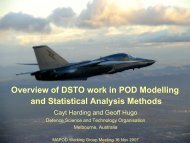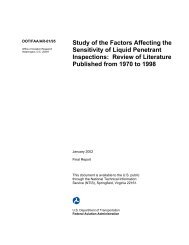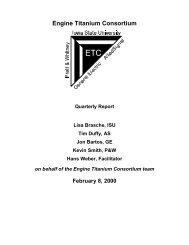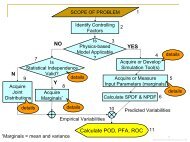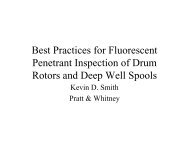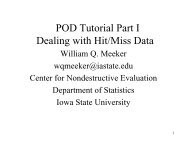Engine Titanium Consortium - Center for Nondestructive Evaluation ...
Engine Titanium Consortium - Center for Nondestructive Evaluation ...
Engine Titanium Consortium - Center for Nondestructive Evaluation ...
You also want an ePaper? Increase the reach of your titles
YUMPU automatically turns print PDFs into web optimized ePapers that Google loves.
the high-noise coupons shown in the figure, resulting in 30.6%, 43.0% and 36% <strong>for</strong> the PW, HW<br />
and GE coupons respectively.<br />
In addition to the S/N measurements, sonic pulse volumes were also measured. First, the –6dB<br />
beam diameter at the FBH depth was determined from a fine increment C-scan of the reference<br />
hole in the PW coupon. Figure 4 illustrates the beam diameter determination <strong>for</strong> the same<br />
example, leading to a value of 39.4 mils. Secondly, as illustrated in Figure 5, the pulse duration<br />
was measured by finding the –6 dB points <strong>for</strong> the envelope function of the rectified FBH echo, and<br />
this duration was translated to a pulse length in metal. For the case shown, the pulse length was<br />
36.7 mils, leading to a measured pulse volume of (π/4)(39.4 mils) 2 (36.7mils) = 44,600 cubic mils.<br />
Peak noise vs. pulse volume <strong>for</strong> all measurements is summarized in Figure 6.<br />
PW8<br />
Max. noise<br />
30.6%<br />
HW5<br />
Max noise<br />
43%<br />
GE6<br />
Max. noise<br />
36%<br />
#1/2 FBH ~ 80%<br />
Figure 3. Example of S/N measurements in high-noise <strong>for</strong>ging coupons. Here the FBH holes are<br />
located at the focus of an F6 transducer.<br />
Quarterly Report – January 1, 2002 –March 31, 2002<br />
print date/time: 6/6/2002 - 8:39 AM – Page 61



